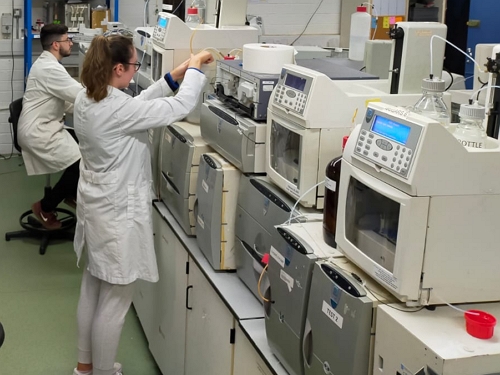Analysis of Hydroxymethylfurfural
The functional side groups found in HMF offer a wide range of applications for which HMF can be used and transformed and it has the potential to be a very useful platform chemical, providing it can be produced economically. HMF can also be inhibitory to some fermentative organisms and hydrolysis enzymes.
Click here to place an order for determining Hydroxymethylfurfural.
Request a QuoteHydroxymethylfurfural Content
Analysis Packages for Hydroxymethylfurfural
Furfural, Levoglucosan, Hydroxymethylfurfural, Acetic Acid, Acetol, 3-Hydroxy-2-butanone, Propanoic Acid, Butanoic Acid, , 2-Cyclopenten-1-one, Methoxymethylfurfural, 3-Methyl-1,2- cyclopentanedione, 2(5H)-Furanone, 3-Methyl-2(5H)-furanone, Phenol, Guaiacol, o-Cresol, Maltol, p-cresol, m-Cresol, Creosol, 2,4-Xylenol, Eugenol, Catechol, Syringol, Vanillin, Hydroquinone, 4-Ethylcatechol, Apocynin, Syringylaldehyde
Equipment Used for Hydroxymethylfurfural Analysis

Ion Chromatography
A Dionex ICS-3000 system that is equipmed with electrochemical, conductivity, and ultraviolet-visible detectors.

Gas Chromatograph with Mass Spectrometer (GC-MS)
Our lab has an Agilent 6890 gas chromatograph (GC) coupled to an Agilent 5973 mass selective detector (Mass Spectrometer).
The DIBANET process chain, as a result of its patented pre-treatment stage, has significantly increased the yields of levulinic acid, formic acid, and furfural beyond what was considered to be the state of the art. By fractionating lignocellulosic biomass into its three main polymers (cellulose, hemicellulose, lignin) it has also allowed for lignin to be recovered and sold as a higher-value product. These developments have meant that the amount of acid hydrolysis residues (AHRs) that have been produced are significantly (up to 88%) less than in the Biofine process. These AHRs are required to provide process heat for DIBANET. Direct combustion is the most efficient means for doing this. If such combustion does not occur and the AHRs are instead used in other processes, e.g. pyrolysis and gasification, then more biomass will need to be purchased to fuel the core DIBANET process. The AHRs have not been proven to be superior to virgin biomass when put through these thermochemical processes. Indeed, many of the results from DIBANET Work Package 4 indicate the opposite. Hence, given that DIBANET, and the modelling of its optimal configuration, is designed on the basis of an integrated process, centred on the core element of the acid hydrolysis of biomass, then combustion is the only viable end use for the AHRs.
| ||
The processing of lignocellulosic materials in modern biorefineries will allow for the
production of transport fuels and platform chemicals that could replace petroleum-derived
products. However, there is a critical lack of relevant detailed compositional information
regarding feedstocks relevant to Ireland and Irish conditions. This research has involved the
collection, preparation, and the analysis, with a high level of precision and accuracy, of a
large number of biomass samples from the waste and agricultural sectors. Not all of the
waste materials analysed are considered suitable for biorefining; for example the total sugar
contents of spent mushroom composts are too low. However, the waste paper/cardboard
that is currently exported from Ireland has a chemical composition that could result in high
biorefinery yields and so could make a significant contribution to Ireland’s biofuel demands. | ||
Additional Material
We can determine the Hydroxymethylfurfural content of various liquids, including liquids from pre-treatment and hydrolysis processes, click here to learn more about our various methods for analysing process liquids.
We can determine the Hydroxymethylfurfural content of pyrolysis bio-oils, click here to learn more about our various methods for analysing bio-oil.



